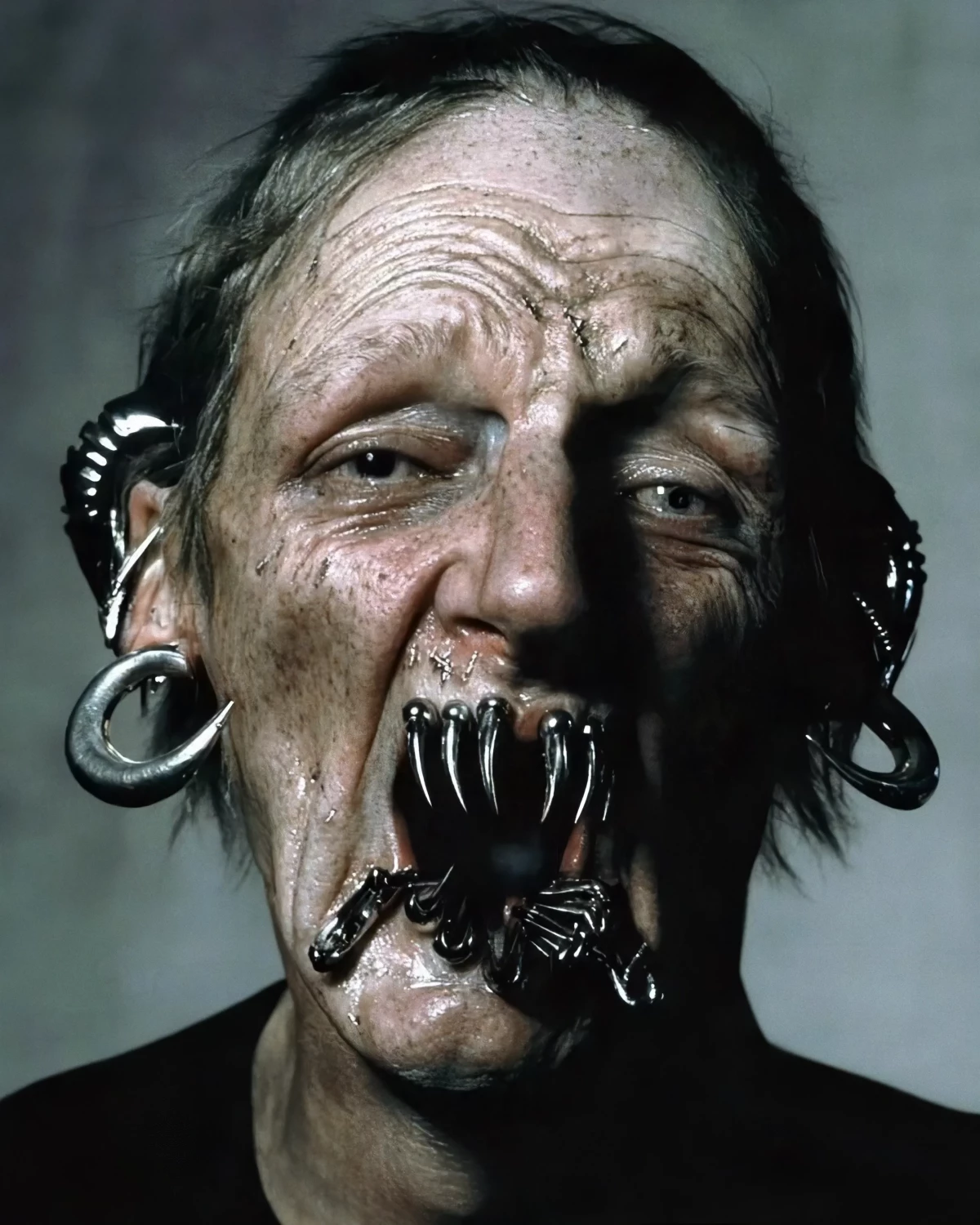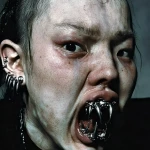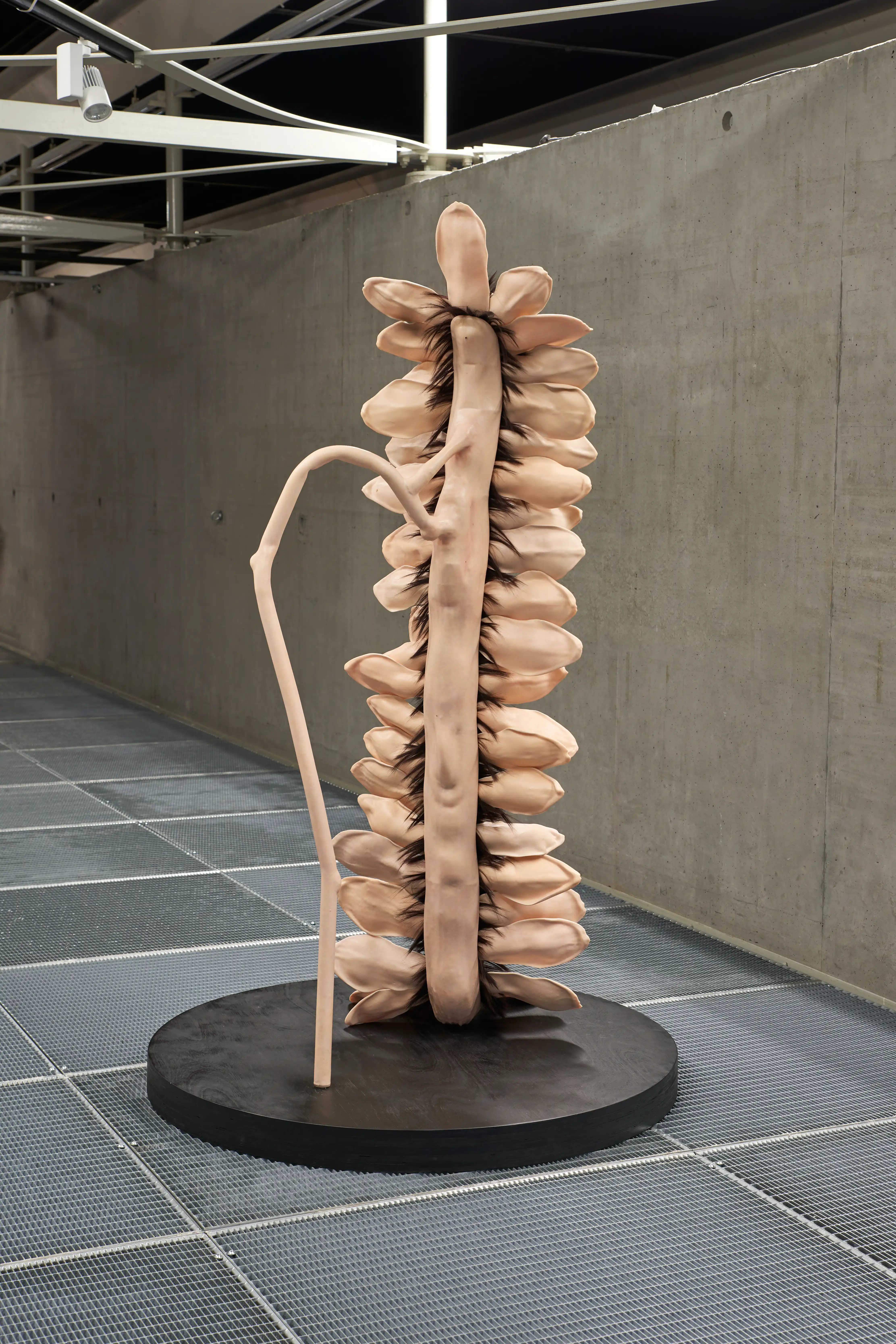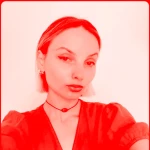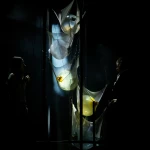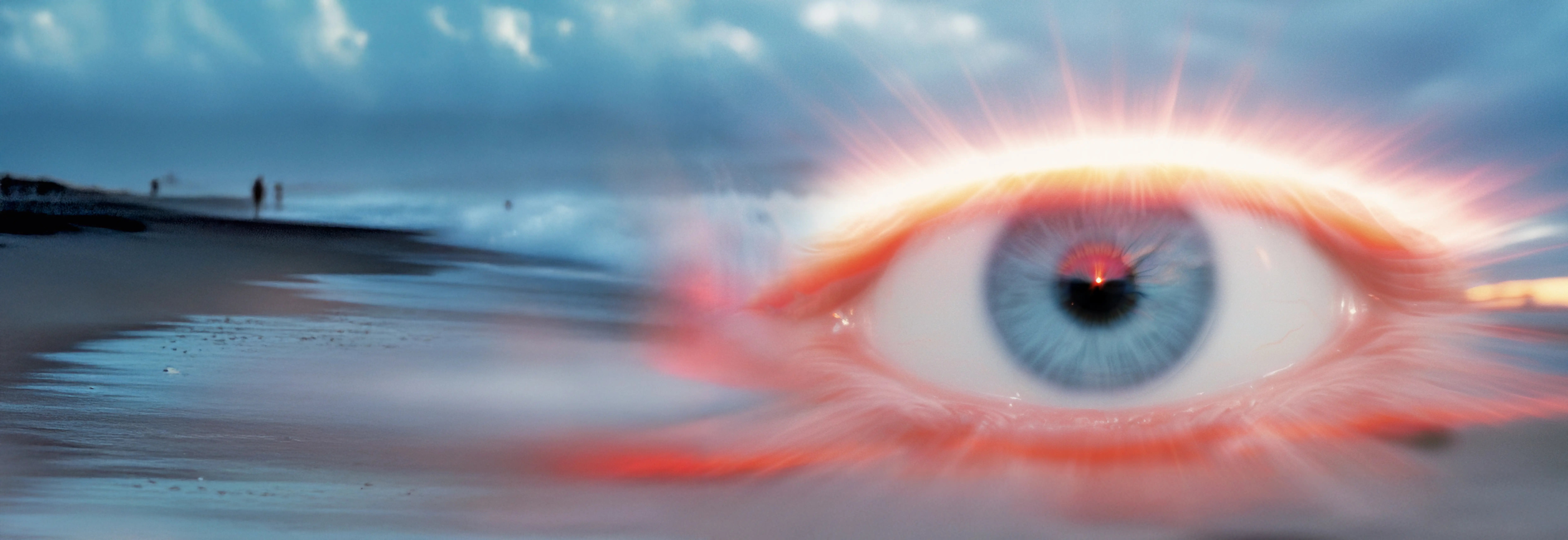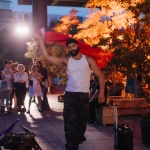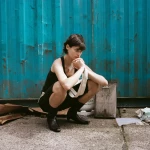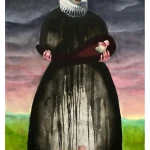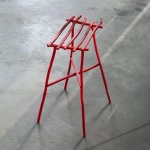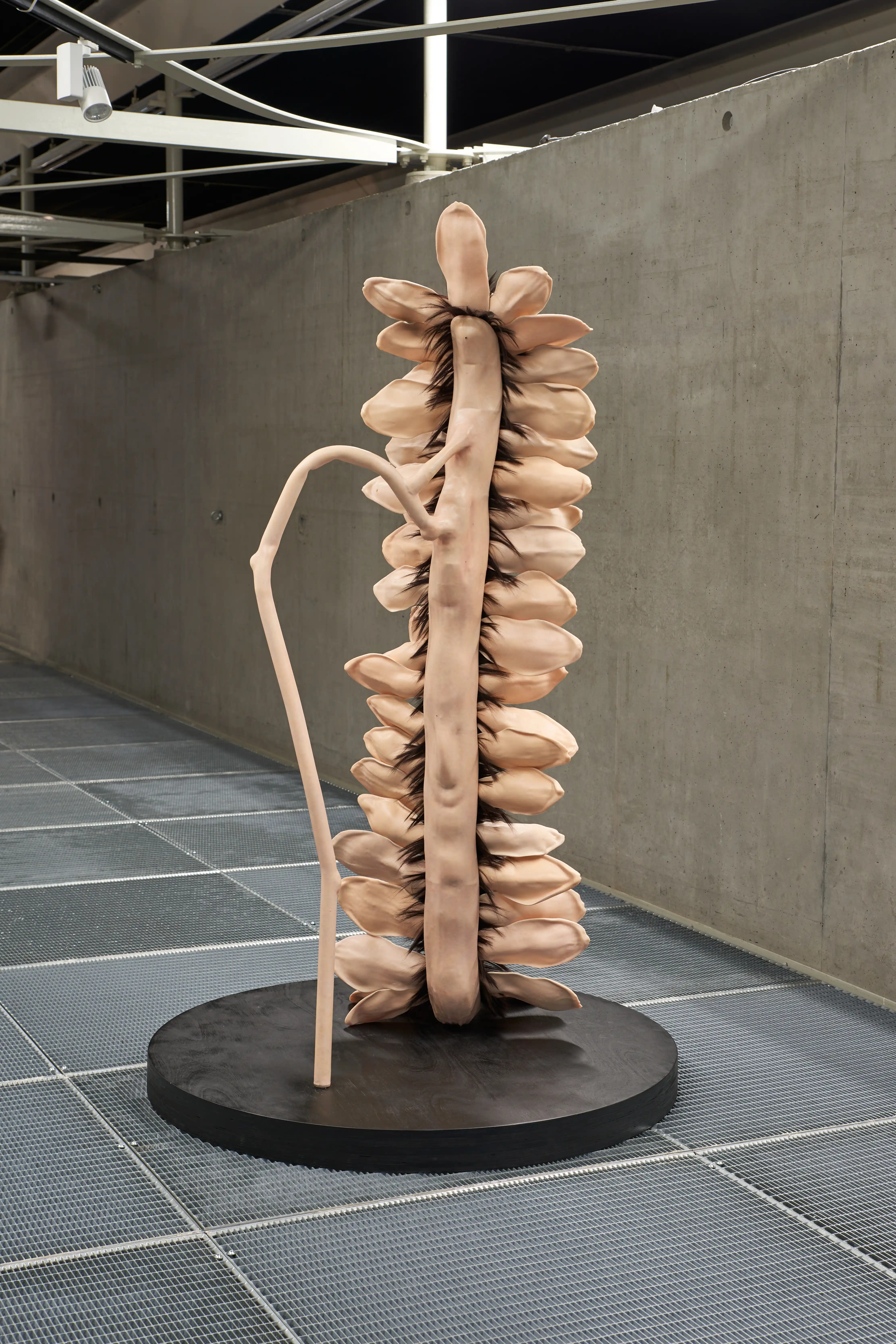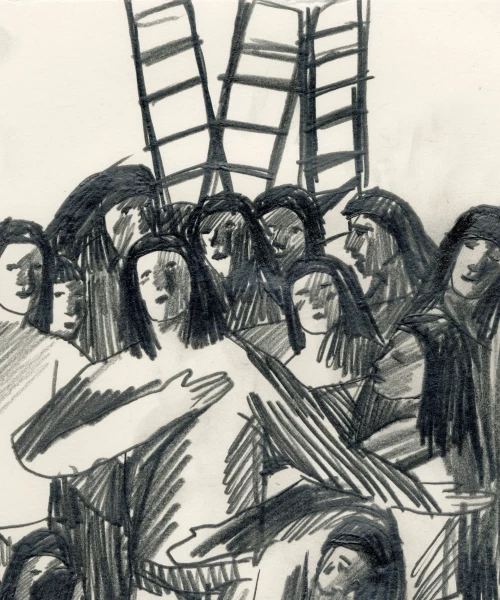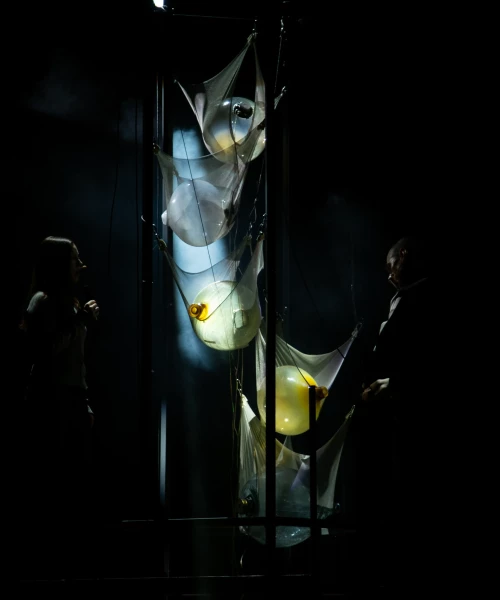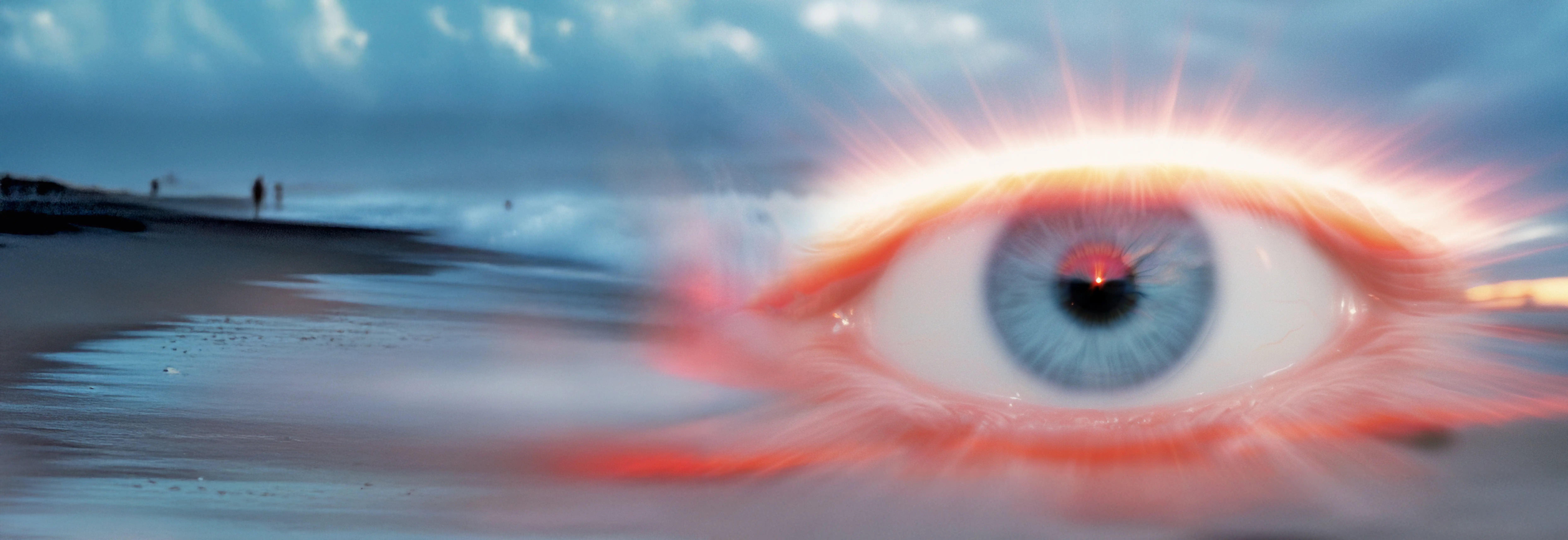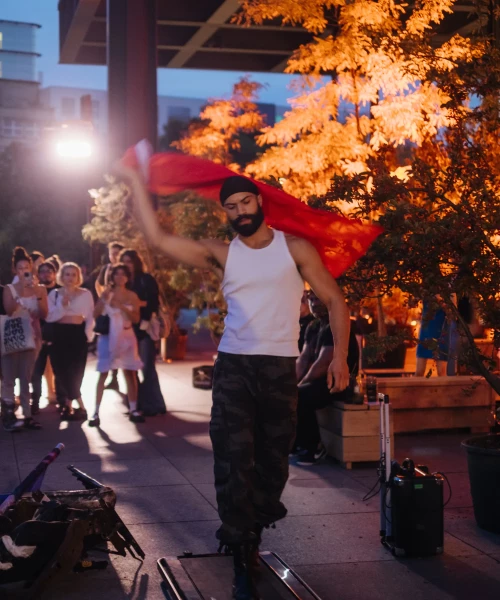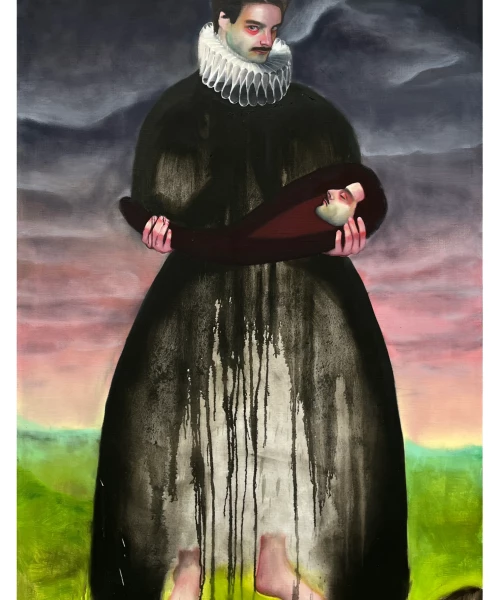Born from the depths of internet research, Bernardo Martins aka Figa’s hyper-realistic cosmology serves as a conduit for the raw truths we often choose to evade. In our systems of paradox, where access to information is inversely proportional to the detachment of its implications, his universe prompts us to reconsider our relationship with the imagery that shapes our collective understanding of beauty, depth, and suffering.
What would you like to be asked?
I don’t think I intend to open up any conversation about me. I understand art has to open up conversations. But if you ask me what questions I want to be asked, it implies that I want to answer. I don’t want to give answers to anything.
But Still, you are sitting here with me. Meaning there is something about you that wishes to be reached.
Yet, I sometimes feel the need to distance myself from what I do: if I don’t attach myself to it, I can protect it more.
We are post-internet kids. Not only aesthetically, but also because of how this technology shaped our social construction, as this webwork of meaning.
Our generation had our identity and personalities shaped by the experiences we lived online. I remember triggering things that happened online that follow me to this day. Talking to people could become very dark. I think our generation was overly exposed.
Do you remember your earlier contacts with a computer?
When I was 4 my mother started dating my adoptive father. Their social and financial background was very different. So the computer would be in his house. It was something that I was accessing but I knew was not part of my world yet.
You were entering these foreign lands, foreign territories.
Understanding what it was.
This father figure appears and shapes your emotional structure on so many levels.
Literally. And the internet came into my everydayness when my mom and I moved with my dad to another city.
What is your first memory of being able to create something?
Through the computer too. I remember when Windows, Word, and Paint showed up. My father had so many digital cameras and I could play with the digital pictures on the computer myself. Sometimes I would draw on them, or do something cute like B&W, but I would press save, and then the original was gone – no backup file. That was something that used to happen.
Editing their narrative as a family through a kid’s gesture.
Later I was only allowed to play with my own pictures.
Was there any point at which you started perceiving yourself as an artist?
I wouldn’t dare to say so, especially when working with AI. I don’t intend to label anything as anything.
And yet, I see it as a category that transcends the work. It is the self-experience through the work that goes beyond the output itself.
I agree. But in terms of a particular moment. I just thought I was queer, and it shaped my personality for a long time. And I thought that was all. ‘Artist’ is a term that never crossed my mind. Today I can see, that even though I do not feel there is an end goal, I know that I am expressing what I feel, and for some that is art.
Trust in your ability to express what you feel.
And the times.
The feeling of our times.
That is exactly it, that’s all I am doing.
A channel.
Yes, I am channeling. For a while I used photography, and though I still miss it, depicting reality does not appeal to me anymore.
Even though you started taking pictures digitally, you grabbed a professional camera at some point.
Yes, but not until I moved to Portugal and got into a university for Photography. It was then that I became more intimate with the camera rather than focusing on the design aspects of fashion itself.
The aspect of fashion that struck you was this sense of crystallized character building.
It was always the image.
What moves you at the deepest level?
We are talking about all these things, this progression. But I feel it was something around me, everyone went through it at the same time. The democratization of a camera, exploring digital personas.
Again, I think it has to do with channeling the feeling of an era. The capacity of being self-observant enough to be in the process while taking distance to understand and trust why you are doing what you are doing: what leads us organically to impossible synchronicities.
I really don’t know how I would have done anything else.
I call it being in alignment.
It is easy now to trace a pattern, but at that moment I was just doing it. Not just in a natural way. It was also pleasurable.
That's always your guiding force.
Yes, but also I don’t tend to cut it. Work is work.
How do you trace the line between work and your autonomous exploration?
My autonomous exploration is work. But when I am exploring, there are no questions; nothing to answer, necessarily. Nothing to achieve or go anywhere specifically. I am there to surprise myself.
That’s when you enter this state of creation.
I distanced myself from photography because I was just fed up with trying to convey people to themselves, they would analyze how they looked. AI allowed me to make portraits that I am drawn to by impression. But I don’t need to serve anyone’s expectations of themselves. Yet now, when people come to me through a commission they still wish to see themselves.
So inevitably, your work is always leading to that.
I think that’s why I was drawn to fashion. The fashion elements in the end are the human body itself.
It is the human body, but it is also an epoch, an era, a level of collective understandings. Which is what we were speaking about earlier.
Yes, exactly. There is a connection there.
I am curious to know if people’s caution towards the way you portray them is simultaneously a reflection of what you experience yourself.
Yes. Totally. And the images I make in this sense, are very in-topic
Dysmorphia is a word that fits the collective body.
I have a screenshot to show to you.
The quality of the ominous is very present in old narratives, even the scatologic, as intrinsic parts of the human condition.
Yes, it has been around us and we talked about it forever. Our conceptions of demons and mythical beings are not always beautiful, almost never actually.

The full spectrum goes from beauty to ugliness and experience can be traced throughout the two ends.
And both are equally important. It is important to talk about the ugly, disgusting, and vile. It is there, it has always been there.
At the same time, the systems of thought we chose to follow through the last millennium in the West are pondering only beauty.
It has to do with this democratization of imagery, and the access we have to portray ourselves online. We are always striving to make a beautiful image of ourselves and our surroundings: at a café, a view of a park, to convey this idea.
Yet when we are struck with a clearly ugly image it presses some internal buttons, to the point it can be almost comforting.
It makes you feel alive too. ‘Oh, I am here’, and you know it. That’s the type of reaction.
A sudden sense of becoming complete. As I am probably seeing a part of that within myself.
I like watching movies that make me feel really uncomfortable because I can be fully present. I can remind myself that I am there: disgusted, angry, or sad. I appreciate when something goes to the extreme. Yet there is something about sensitive topics that depends on your intention and background. There is a fine line between fetishizing and criticizing.
Trying to grasp the ominous.
It is trying to discuss this, for sure. Yet it simply is, it does not need to try. And by being, we can therefore discuss, “How do you feel?”
I like this way of catalyzing discussion. Especially what you previously mentioned, about the thin line, that makes you wonder.
I think it is about making the right critic. Are you in the right place to make this critique, to talk about that? There are some topics that not everyone is the best spokesperson for.
Tell me about your alter-ego as a creator.
I use Figa, which is this symbol (hand sign) not of good luck, but to keep away the bad eye. It is a charm. And it also means “fuck you”.
So if you had to enter a realm in which the energy feels charged you would do this sign to be protected?
I am not sure if I am that conscious, I am kind of cynical. My mom, for instance, believes she is unlucky, and that it’s her Karma. I prefer to follow a philosophical line of thought that is not around the things that happen to you but rather how you respond and react to them.
From the karma perspective, you have only two options: to create more karma or to release karma through an experience.
We need to get through this and the struggles are worth it. But we need to be smart about it. To understand where you have to press points and where you don’t need to.
If you would have to draw or trace a landscape of yourself, what would be on that landscape?
Some Berlin characteristics for sure, either the architecture or the greyness. That is a great part of me. My understanding of what a big city means started there: how to navigate and probably survive it, and how to interact. When I moved here I had never had the big-city-slap-on-the-face before. It is a really big chunk of my understanding of autonomy, even if I don’t want Berlin to define my identity. Both the sadness of the winter, the longing of not being able to go home easily, the struggle— and also the joy of being able to live this complex kind of life.
I think it connects with not pondering only beauty as a canon but finding beauty in the whole spectrum. Do you have any rituals in your practice?
I usually work very, very, very late. I get the best things [results] after 2:30 AM and then I keep going until 5:30 AM. My thirst to get something that I really love gets sparked. I need to, and I try again. AI is based on trial and error.
What is your inner process like? Since the moment you turn ON the computer.
People are very triggered by AI because it is trained on someone’s work; online images. But I think I really challenge myself to make something completely different from anything else–it is very hard to emulate even my research, you know. I go hard on that.
It has a lot to do with experiencing the pre-algorithmic, early internet. The never-ending jumps in between URLs. No internet-engineered search can be identical to another.
That is so special. My favorite images that I have done are not text-based.
A return to the pre-verbal.
To allow the computer to interpret the textures, the shades, and the colors, rather than words, which can be so obvious.
A mental imprint of a word is conditioned by individual associations, our background, and how we were socialized, right? This is such a constrictive way of perceiving.
I was asked once if prompting words can be a form of poetry. Is poetry your background?
I see it as a foreground, what I try to pursue in my everyday life: a hybrid, dysmorphic idea of how something is supposed to be. Do you think of your work as an expansive mythological world? Do you trace connections between the entities you create?
There are a few topics. The Encosto entities are one. It relates not only to the collective way of living here but also how sad the winter can get, I think it talks a lot about these entities; that are non-existent.
But they are within us maybe, our own shadows, the shadow side.
I think it is such a funny concept. In Brazil, we don’t have anywhere to place these feelings. But here winter is really a tough time. I find it is funny that you would put these feelings into something spiritual, what you are getting from a physical reaction, obviously. Unless the city is cursed. What do you think?
I think it’s beautiful how this primary influence you had is now a way in which you interpret reality on this almost sociological level. Do you have nightmares?
I see myself as a non-believer but I think it’s very cynical. When I explain why I bring up this Encosto entity I make fun of it because if it is true it means I would have it within me. After all, I have felt a lot. When living in an apartment from 1870 near Kotti, a very old building, weird vibes. I had bad nightmares all the time. Seeing the sleep paralysis demon face to face, on the top of the ceiling down.
You used skepticism as a means of coping.
But I felt it. Sleep paralysis is like this wave of fear, something that crosses your spine. A friend from Brazil came over and slept for a few nights and said, ‘Yes, there is someone here. I have seen a person in this apartment for the past two days. And I was, ‘Why would you ever tell me this? So I am hosting you and you are telling me this...’ Haha.
Contact with the unknown.
I grew up in many of these spiritual surroundings on my mom’s side. My mother and grandmother used to go to a Terreiro, which is a common private house, to practice their beliefs, a place to worship, and to receive their blessings. It is so, so real. It is insane.
And they don’t have any imagery? Like catholicism?
They do because the African influence is mixed with catholic references. The Portuguese didn’t know they were practicing other beliefs.
I love how your way of perceiving reality is influenced by the level of “what is seen” by your father’s lineage: cameras, and images and on your mother’s side through “the unseen”, all that exceeds the visual.
Yes, and I think that because of social disparity. My mom’s side is much more connected to the emotional. And my father’s side seeks to be surrounded by positive things exclusively. Only the light. And at times that is so suffocating.
The entities fight to come out.
You feel the Encostos.
The sense of thirst to create during the night is connected to how you allow the “Encostos” to come to you in a way that channels through, instead of harming.
I feel everyone has destructive patterns but I choose to live with it. If I deny it, it would still be there. The “Encosto” series began with this piece I started to make and then these beings came along. Super small, but still human, and just scary. A Horcrux type of existence. This grey fetus is a seed of this rotten thing that lives inside us. This thing I can’t get rid of so I have to learn to live with it.
I find it beautiful how it all connects.
Some people create to improve their surroundings, in a way uplift, to talk about the positive can be more comfortable. But I don’t reject the idea of influencing my surroundings, even though I work with the bizarre.
Improving in connection to holding space to integrate the darkness. I believe that the Encosto is very connected with C.G. Jung’s concept of the shadow. This part of us pushes to be seen and expresses itself through destructive patterns, nightmares, or neurosis; and on the collective body level, throughout cyclical conflicts and tragedies.
Where digits of massacres become mere information, Figa’s exploration underscores how the visual morphs suffering into abstraction, offering an embodied confrontation to what is often suppressed.

